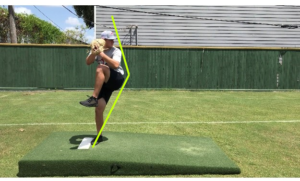Increasing pitching velocity is a complex process and often requires improving many different elements. One of these elements includes biomechanical efficiency. Inefficient movements can lead to lower pitching velocity. One important part of efficient pitching mechanics involves a player’s energy angle, which is how a pitcher directs energy from first movement to maximum leg lift. Essentially, this measurement is how far the athlete’s center of mass has traveled toward the plate.
Energy Angle, Forward Momentum, and Pitching Velocity

Youth pitching coaches often try to get pitchers to shift back toward second base before maximum leg lift. However, this can create a weak energy angle that may stop early forward momentum. Many of the best pitchers in the world take advantage of early forward momentum for velocity. A strong energy angle can help indicate this early momentum. The problem with leaning back until maximum leg lift is that a player must start forward momentum from just one leg on the ground instead of two. This is an inefficient way to create momentum for pitching.
Instead, starting forward momentum immediately upon leg lift can help the player reach maximum momentum. Leaning back until maximum leg lift and creating a lower energy angle naturally delays forward momentum and, therefore, decreases pitching velocity. This may also throw off timing and increase the amount of time to footstrike. This means that the body is actually traveling faster when players have a strong energy angle.
Benefits of a Strong Energy Angle
We’ve conducted studies on the effect on energy angle and found that a strong energy angle did have positive effects on pitching velocity. Also, studies show that a strong energy angle is associated with a longer average dragline distance. Momentum and stride affect dragline distance. Creating a weak energy angle by staying back or stopping at the top of the pitch can lead to inefficient biomechanics, sequencing, and timing. Any or all of these inefficiencies may have a negative effect on performance. Therefore, research shows that encouraging a strong energy angle may help players learn how to become better pitchers.
At National Pitching, our goal is to help good pitchers become great. Our science-backed pitching lessons are designed specifically for rotational athletes. The National Pitching program gives athletes of all ages a toolkit for success. We help you increase functional strength, pitching velocity, mechanics, and overall performance. Our training protocols are based on health, science, and biomechanical studies of pitchers and other rotational athletes. If you’re ready to get started on the National Pitching program, join our V.I.P. online membership today or find a pitching coach near you. We are here to help you.
